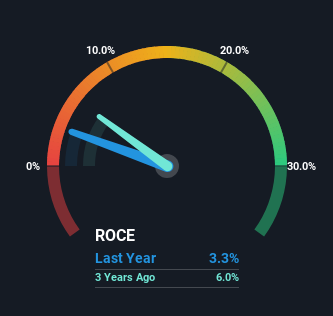- South Korea
- /
- Leisure
- /
- KOSE:A002450
SAMICK MUSICAL INSTRUMENT's (KRX:002450) Returns On Capital Tell Us There Is Reason To Feel Uneasy
What underlying fundamental trends can indicate that a company might be in decline? Businesses in decline often have two underlying trends, firstly, a declining return on capital employed (ROCE) and a declining base of capital employed. This indicates the company is producing less profit from its investments and its total assets are decreasing. And from a first read, things don't look too good at SAMICK MUSICAL INSTRUMENT (KRX:002450), so let's see why.
Understanding Return On Capital Employed (ROCE)
For those who don't know, ROCE is a measure of a company's yearly pre-tax profit (its return), relative to the capital employed in the business. The formula for this calculation on SAMICK MUSICAL INSTRUMENT is:
Return on Capital Employed = Earnings Before Interest and Tax (EBIT) ÷ (Total Assets - Current Liabilities)
0.033 = ₩13b ÷ (₩530b - ₩126b) (Based on the trailing twelve months to March 2024).
Thus, SAMICK MUSICAL INSTRUMENT has an ROCE of 3.3%. In absolute terms, that's a low return and it also under-performs the Leisure industry average of 12%.
View our latest analysis for SAMICK MUSICAL INSTRUMENT

While the past is not representative of the future, it can be helpful to know how a company has performed historically, which is why we have this chart above. If you'd like to look at how SAMICK MUSICAL INSTRUMENT has performed in the past in other metrics, you can view this free graph of SAMICK MUSICAL INSTRUMENT's past earnings, revenue and cash flow.
The Trend Of ROCE
We are a bit worried about the trend of returns on capital at SAMICK MUSICAL INSTRUMENT. About five years ago, returns on capital were 6.1%, however they're now substantially lower than that as we saw above. And on the capital employed front, the business is utilizing roughly the same amount of capital as it was back then. This combination can be indicative of a mature business that still has areas to deploy capital, but the returns received aren't as high due potentially to new competition or smaller margins. So because these trends aren't typically conducive to creating a multi-bagger, we wouldn't hold our breath on SAMICK MUSICAL INSTRUMENT becoming one if things continue as they have.
On a side note, SAMICK MUSICAL INSTRUMENT has done well to pay down its current liabilities to 24% of total assets. That could partly explain why the ROCE has dropped. What's more, this can reduce some aspects of risk to the business because now the company's suppliers or short-term creditors are funding less of its operations. Some would claim this reduces the business' efficiency at generating ROCE since it is now funding more of the operations with its own money.
The Key Takeaway
In the end, the trend of lower returns on the same amount of capital isn't typically an indication that we're looking at a growth stock. Investors haven't taken kindly to these developments, since the stock has declined 25% from where it was five years ago. Unless there is a shift to a more positive trajectory in these metrics, we would look elsewhere.
If you want to know some of the risks facing SAMICK MUSICAL INSTRUMENT we've found 4 warning signs (1 is potentially serious!) that you should be aware of before investing here.
While SAMICK MUSICAL INSTRUMENT may not currently earn the highest returns, we've compiled a list of companies that currently earn more than 25% return on equity. Check out this free list here.
New: Manage All Your Stock Portfolios in One Place
We've created the ultimate portfolio companion for stock investors, and it's free.
• Connect an unlimited number of Portfolios and see your total in one currency
• Be alerted to new Warning Signs or Risks via email or mobile
• Track the Fair Value of your stocks
Have feedback on this article? Concerned about the content? Get in touch with us directly. Alternatively, email editorial-team (at) simplywallst.com.
This article by Simply Wall St is general in nature. We provide commentary based on historical data and analyst forecasts only using an unbiased methodology and our articles are not intended to be financial advice. It does not constitute a recommendation to buy or sell any stock, and does not take account of your objectives, or your financial situation. We aim to bring you long-term focused analysis driven by fundamental data. Note that our analysis may not factor in the latest price-sensitive company announcements or qualitative material. Simply Wall St has no position in any stocks mentioned.
About KOSE:A002450
SAMICK MUSICAL INSTRUMENT
Together with subsidiaries, manufactures, and sells musical instruments in South Korea.
Good value average dividend payer.
Market Insights
Community Narratives



